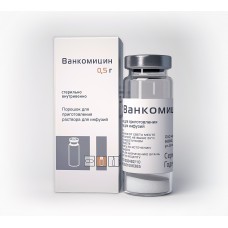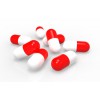Expiration date: 12/2026
Composition
1 vial contains vancomycin (hydrochloride) 0.5 or 1g.
Packaging
Bottle 0.5 or 1g.
Pharmacological action
Antibiotic groups of the glycopeptides. Vancomycin has a bactericidal effect. It violates the synthesis of cell wall, permeability of cytoplasmic membrane and synthesis of RNA bacteria. Active against gram-positive bacteria: Staphylococcus spp. (including strains producing penicillinase and methicillin-resistant strains), Streptococcus spp., Enterococcus spp., Corynebacterium spp., Listeria spp., Actinomyces spp., Clostridium spp. (including Clostridium difficult). There was no cross-resistance with antibiotics of other groups.
Indications
Infectious and inflammatory diseases of severe course caused by pathogens sensitive to Vancouver (in case of inefficiency or intolerance of penicillins and cephalosporins): sepsis, endocarditis, pneumonia, lung abscess, meningitis, osteomyelitis. Pseudomembranous colitis caused by Clostridium difficult.
Contraindications
Neuritis of the auditory nerve, the first trimester of pregnancy, severe renal dysfunction, hypersensitivity to vancomycin.
Application during pregnancy and breast-feeding
Application in the first trimester of pregnancy is contraindicated due to the risk of nephro - and ototoxicity. The use of vancomycin in II and III trimestrah possible only for health reasons. If necessary, use during lactation breastfeeding should be stopped.
Method of application and doses
Give/in the drip. Adults - 500 mg every 6 h or 1 g every 12 h to avoid collaptoid reactions the duration of infusion should be no less than 60 minutes Children 40 mg/kg/day. each dose should be administered at least 60 min. in patients with impaired renal excretory function, reduce the dose to a given value of KK. Depending on the etiology of the disease Vancomycin can be taken orally. For adults, the daily dose is 0.5-2 g in 3-4 divided doses, for children - 40 mg/kg in 3-4 divided doses. The maximum daily dose for adults with on / in the introduction is 3-4 g.
Side effect
With rapid on / in the introduction may develop "red neck syndrome" associated with the release of histamine: erythema, skin rash, redness of the face, neck, upper half of the trunk, hands, rapid heartbeat, nausea, vomiting, chills, fever, fainting.
From the urinary system: violation of urination, interstitial nephritis.
From the Central nervous system: hearing loss, ringing and feeling of "laying" in the ears.
From the hematopoietic system: neutropenia, eosinophilia, thrombocytopenia, agranulocytosis.
Allergic reactions: skin itching, urticaria, anaphylactic reaction.
Special instruction
Use in II-III trimester of pregnancy is possible only by "living" testimony. In the appointment of preterm and normal newborns desirable control over the concentration in the blood serum. While taking with General anesthetics increases the frequency of side effects, so it is better to introduce Vancouver before General anesthesia. During treatment, it is necessary to conduct an audiogram, determine kidney function (urine analysis, indicators of creatinine and urea nitrogen). It is desirable to determine the concentration of vancomycin in serum (in patients with renal insufficiency, in patients older than 60 years). The maximum concentration should not exceed 40 mcg/ml, and the minimum is 10 µg/ml. Concentrations above 80 µg/ml are considered toxic.
Drug interaction
At simultaneous appointment with local anesthetics in children may appear erythematous rashes and hyperemia of the skin of the face, in adults - violation of intracardiac conductivity. Simultaneous administration with nephro - and ototoxic drugs (aminoglycosides, amphotericin B, ask or other salicylates, bacitracin, bumetanide, capreomycin, carmustin, paromycin, cyclosporin, "loop" diuretics, polymyxin B, cisplatin, ethacrinic acid) is not recommended. Cholestyramine reduces the effectiveness. Antihistamines LS, meclozin, phenothiazines, thioxanthenes can mask the symptoms of ototoxic action of Vancouver (tinnitus, vertigo). General anesthetics and vecuronium bromide, the risk of reduced blood pressure or the development of neuromuscular blockade. The infusion of Vancouver is possible at least 60 minutes before their administration.
Overdose
Symptoms: increased severity of side effects.
Treatment: treatment is symptomatic in combination with hemoperfusion and hemofiltration.
Storage conditions
At a temperature of 15-30 °C.



